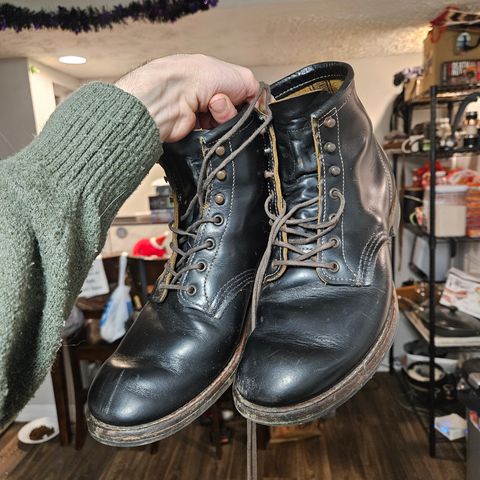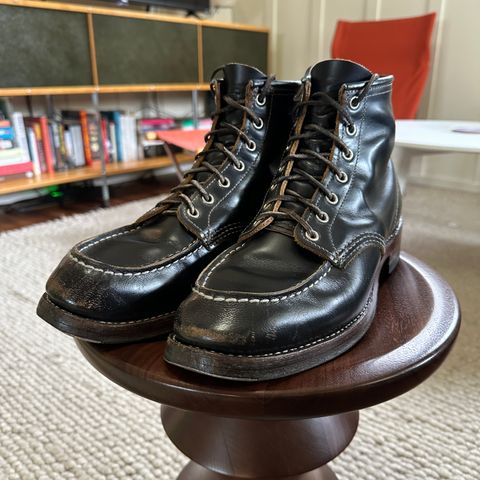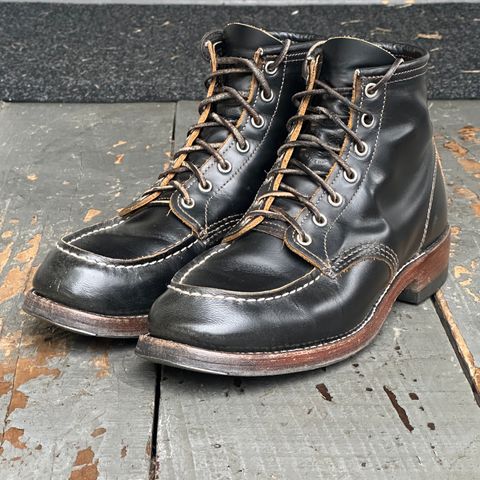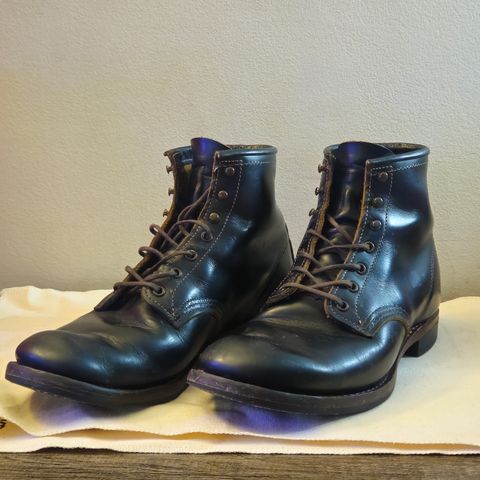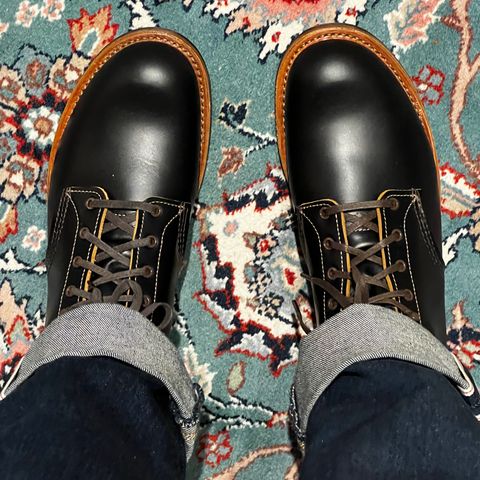About
S.B. Foot Black Klondike is a color variation of Klondike leather, a distinctive teacore-style leather produced by S.B. Foot Tanning Company in Red Wing, Minnesota. This specialized leather features a black surface finish applied over a brown leather base, creating the signature teacore characteristic where the underlying brown tones gradually emerge through wear and use. Black Klondike exemplifies the teacore aging property that has made Klondike leather sought-after among heritage footwear enthusiasts.
About
S.B. Foot Black Klondike is a color variation of Klondike leather, a distinctive teacore-style leather produced by S.B. Foot Tanning Company in Red Wing, Minnesota. This specialized leather features a black surface finish applied over a brown leather base, creating the signature teacore characteristic where the underlying brown tones gradually emerge through wear and use. Black Klondike exemplifies the teacore aging property that has made Klondike leather sought-after among heritage footwear enthusiasts.
The black color variation represents the most dramatic teacore presentation in the Klondike family. Where the black finish completely obscures the brown core when new, even minor scuffs and flexing quickly begin revealing the rich brown leather beneath. This stark contrast between the deep black surface and warm brown undertones creates an evolving visual character that makes each piece unique to its wearer's use patterns and maintenance approach.
Characteristics
Black Klondike shares the fundamental properties of all Klondike leathers while presenting distinctive visual characteristics unique to the black color variation. The leather features a smooth, oiled surface with the substantial hand-feel characteristic of chrome-tanned, oil-finished leathers. The black finish provides initial uniformity but does not fully obscure the natural grain texture, allowing close inspection to reveal the full-grain leather structure beneath.
The teacore construction creates one of the most visually striking aging progressions available in heritage footwear. The complete black coverage when new means that any surface abrasion immediately reveals contrasting brown tones. High-flex areas develop brown highlights within the first weeks of wear, while protected surfaces maintain their black finish for extended periods. This differential aging creates a variegated appearance that continuously evolves throughout the leather's life.
The leather maintains water resistance, stain resistance, and abrasion resistance through S.B. Foot's established oil-tanning foundation. The black surface finish, while designed to wear away gradually, provides initial protection and helps the leather shed light surface dirt. As the brown core becomes more prominent, the leather develops the warm, lived-in appearance characteristic of aged teacore materials.
Color and Appearance
Initial Presentation
Black Klondike presents a deep, solid black surface when new, with subtle variations in sheen indicating the oiled leather base. The smooth finish creates consistent color across each hide, though natural grain variations remain tactilely present beneath the surface coating. Under direct lighting, the black shows slight brown undertones at extreme flex points, hinting at the transformation to come.
Aging and Patina Development
The teacore aging process begins immediately with first wear. Vamp creases, toe boxes, and heel counters show the earliest brown breakthrough, as these high-stress areas experience maximum surface abrasion. Within the first month of regular wear, distinct brown striations appear along natural flex lines, creating a lightning-bolt pattern that emphasizes the boot's movement and use.
Extended wear produces increasingly prominent brown areas that gradually expand from initial breakthrough points. Six months of active use typically transforms the appearance from predominantly black with brown accents to a rich brown base with black remaining only in protected areas. The specific progression varies significantly based on wear intensity, environmental conditions, and maintenance practices.
Comparison with Other Klondike Colors
Black Klondike offers the most dramatic visual transformation within the Klondike family. Where other teacore finishes may present subtler aging progressions, the stark black-to-brown transition creates maximum visual impact. This makes Black Klondike particularly appealing for wearers who value obvious patina development and boots that dramatically reflect their use history.
Production
S.B. Foot Tanning Company produces Black Klondike at their Red Wing, Minnesota facility using the same chrome-tanning foundation employed for all Klondike leathers. Hides undergo the traditional 14 to 20-hour drum processing cycle in wooden drums, soaking in specialty tree oils, tanning agents, and the brown base dyes that will eventually show through the black finish.
The black surface finish distinguishes this variation from other Klondike colors. Technicians apply the black coating through specialized spray techniques, creating a layer carefully calibrated for optimal teacore aging. The finish must provide initial durability and water resistance while remaining thin enough to reveal the brown core through natural wear patterns. This balance requires precise control of application thickness and finish composition.
Quality control processes ensure consistency in both the brown base color and black surface finish. Each hide undergoes visual inspection to verify even black coverage and appropriate brown undertone that will emerge during aging. The result is a leather specifically engineered to transform through use while maintaining structural integrity throughout its life.
Care and Maintenance
Cleaning
Black Klondike benefits from regular cleaning to remove surface dirt and debris that can accelerate uneven finish wear. Use warm water and a soft bristle brush to remove accumulated dirt, working in circular motions to avoid creating artificial wear patterns. For heavier soiling, apply Foam Leather Cleaner with a brush or cloth, then wipe away with a damp cloth and allow to dry completely.
Unlike heavily pigmented leathers, surface scratches and scuffs contribute to Black Klondike's character rather than detracting from appearance. Cleaning focuses on removing dirt and grime while preserving the natural aging progression created through wear.
Conditioning
Regular conditioning maintains the leather's oil content and suppleness while supporting even patina development. Apply Leather Cream or Neutral Boot Cream using fingers, cloth, or sponge, working the conditioner into the leather surface. The conditioning process helps soften the black finish, facilitating more gradual aging and preventing the abrupt flaking that can occur with dried-out teacore finishes.
Color-specific boot creams can temporarily cover prominent scuffs for occasions requiring more uniform appearance, though this approach works against the leather's designed-for-aging character. Most Black Klondike wearers embrace visible wear marks as essential to the teacore aesthetic.
Protection and Long-Term Care
Leather Protector, lightly misted from six to eight inches away, provides an invisible shield against moisture, dirt, oil, and mud. This protection helps maintain the black finish in its optimal condition for gradual aging rather than premature deterioration from environmental exposure. Apply protector every few months, particularly before extended wear in challenging conditions.
Storage in cool, dry conditions away from direct sunlight prevents premature finish degradation. Cedar shoe trees maintain shape during rest periods and absorb moisture that could compromise the chrome-tanned foundation. Despite the deliberate aging design, proper care ensures the structural leather beneath the finish maintains integrity for decades of use.
Applications
Red Wing Heritage Footwear
Black Klondike appears prominently in Red Wing Heritage's Engineer Boot 2966, where the leather's dramatic aging complements the classic engineer boot silhouette. The limited-edition 9874 six-inch boot showcases Black Klondike as its signature material, emphasizing clean lines that highlight the leather's transformation. Additional applications include the 9870 round toe boot and the Japanese-exclusive 8829 8-inch Classic Moc Toe, demonstrating the leather's versatility across different heritage styles.
The Beckman Flat Box 9060 features Black Klondike in a dress-casual context, showing how the teacore aging can enhance formal heritage footwear. Each application leverages the leather's unique visual evolution to create boots that develop individual character through wear.
Limited Editions and Special Releases
Black Klondike frequently appears in limited-edition releases and market-specific offerings, particularly for Japanese and European markets where teacore leathers command premium interest. The leather's dramatic aging makes it ideal for collector-focused releases and anniversary editions where distinctive material selection distinguishes the offering from standard production.
Why Choose Black Klondike?
Black Klondike offers the most visually dramatic aging progression available in the Klondike family. The complete black-to-brown transformation creates boots that serve as visible records of wear and care, appealing to enthusiasts who value leather that tells a story through patina development. The teacore characteristic ensures no two pairs age identically, providing genuine uniqueness in an era of mass production.
The leather combines S.B. Foot's proven chrome-tanning quality with a finishing approach that celebrates visible aging. For wearers selecting boots with character development in mind, Black Klondike delivers the compelling combination of dramatic visual transformation and structural durability that decades of American leather-making expertise provide.
Popular Footwear Featuring Black Klondike
Red Wing Heritage's Engineer Boot 2966 showcases Black Klondike in the iconic engineer boot silhouette, pairing the leather's aging properties with the Neoprene Cord outsole and Goodyear welt construction. The limited-edition 9874 six-inch boot emphasizes Black Klondike's transformation potential through minimal detailing and clean lines. The 9870 round toe boot offers a classic work boot aesthetic with Black Klondike's dramatic aging. Japanese market releases like the 8829 8-inch Classic Moc Toe and the Beckman Flat Box 9060 demonstrate the leather's appeal across different boot styles and markets.
References
"Men's Engineer Boot 2966". Red Wing Heritage. Retrieved October 13, 2025.
"S.B. Foot Klondike". Patina Project Wiki. Retrieved October 13, 2025.
"Red Wing 9874 - Black Klondike". Brund. Retrieved October 13, 2025.
